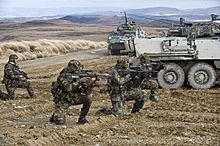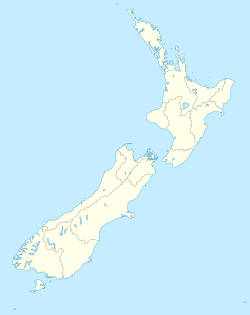Waiouru Military Camp facts for kids
Quick facts for kids Waiouru Military Camp |
|
|---|---|
| Waiouru, New Zealand | |

New Zealand Army soldiers with NZLAVs during "Exercise Hellfire" at Waiouru Army Camp in 2009
|
|
| Coordinates | 39°28′13″S 175°40′49″E / 39.4704°S 175.6803°E |
| Type | Army Camp |
| Site information | |
| Owner | New Zealand Army |
| Controlled by | |
| Site history | |
| In use | 1939–present |
Waiouru Military Camp is a big training base for the New Zealand Army. It's located in the middle of the North Island of New Zealand, close to the town of Waiouru.
All new soldiers joining the New Zealand Army start their basic training here. This training is called the All Arms Recruit Course (AARC). The camp also has a special meeting place called a marae. This marae is known as Ngati Tumatauenga, which means 'the tribe of the God of War' in Māori. It's a special name for the New Zealand Army.
Contents
Waiouru: A Military Training Hub
In the 1930s, the New Zealand government needed a large training area for its soldiers. They picked a sheep farm at Waiouru. This place was chosen because it had lots of open land that wasn't too expensive. It also had good roads and train lines to the coast.
The artillery (soldiers who use big guns) were the first to train at Waiouru. In 1937, a local farm worker named Cedric Arthur wrote about the camp. He mentioned that the military camp was very busy with trucks, tractors, guns, horses, and many soldiers. People were already talking about the government buying more land to make it a permanent camp.
Just one month after World War II began in 1939, the government took over most of the Waiouru farm land.
Building the Wartime Camp
In the winter of 1940, about 800 construction workers got busy. They built a training camp that could hold 7,000 soldiers. In just six weeks, huge amounts of building materials arrived at the Waiouru railway station. Workers moved a lot of earth to create a flat area for the camp. At the same time, hundreds of soldiers lived in tents in the snow while they trained hard.
By Christmas 1940, there were 230 buildings. These buildings were connected by 20 kilometers (12 miles) of streets. There were also 8 kilometers (5 miles) each of water pipes, power lines, and sewers. By mid-1941, seven different camps housed 7,000 soldiers. The camp had a bakery, a hospital, two movie theaters, and five "institutes." Each institute had a concert hall, library, writing room, and tearooms. Soldiers had to go to Taihape if they wanted to buy a beer.
In August 1941, two special schools were set up at Waiouru. These were the Armoured Fighting Vehicle School and the Command and Staff School. By the end of the war, a lot of money had been spent on the camp. About 340 square kilometers (130 square miles) of land had been bought for training.
Growing the Camp After the War
After the war, in 1949, the army needed even more land. They planned to improve the Desert Road through the artillery range. This road would become a major highway. They also planned to build a power line to bring electricity to the Moawhango valley.
The Army Schools from Trentham were going to move to Waiouru. Also, compulsory military training was about to start. As New Zealand's defense focus shifted to South-East Asia, the Army needed forests for jungle warfare training. Because of all these needs, another 250 square kilometers (97 square miles) of land was bought. This land was to the north and east of the camp. In 1955, the 1st NZSAS Squadron began jungle training in Paradise Valley. This area was part of the newly acquired land.
Waiouru's Busiest Times
From 1950 to 1958, many young people did compulsory military training at Waiouru. Later, from 1962 to 1972, national service (where people were chosen by a lottery) also happened here.
In 1978, the National Army Museum opened at Waiouru. In 1985, the Officer Cadet School of New Zealand also opened. These were the busiest years for Waiouru. In the 1970s and 80s, there were 100 different recreational clubs. The Ski Club alone had 300 members! At that time, Waiouru had about 6,000 people living there, including 600 children.
Changes and Continued Use
In the 1980s, some training stopped, and some army units moved to Linton. By 1990, Waiouru's permanent population dropped to about 3,000 people. However, many more soldiers still came for training courses. In 1991, almost three thousand soldiers trained at Waiouru on 275 different courses.
In 2005, the armored forces moved away from Waiouru. The camp's population then fell to about 2,000. But Waiouru is still a very important training area. It's in a central location and has 600 square kilometers (230 square miles) of different types of land. The barracks (soldier living quarters) have 1,400 beds, and they are often full. Many more soldiers stay in smaller camps or sleep in the field during training.
Today, Waiouru is still the main base for TAD (The Army Depot). It is a key training center for the New Zealand Army. Most of the people working at Waiouru help with training courses. This includes the basic training course for all new recruits.
The Future of Waiouru
In 2004, Major General Jerry Mateparae talked about the future of the camp. He said that Waiouru is a big part of what makes the Army special. Most of the challenging training courses happen there. The camp also hosts the School of Military Intelligence and Security. This school is for the New Zealand Intelligence Corps.
Working with Singapore
New Zealand and Singapore have a special agreement. Because of this, the Singapore Army uses Waiouru's live-firing range. They have been testing their large 155 mm howitzer guns there since 1985. These guns include the FH-88, FH-2000, SLWH Pegasus, and SSPH Primus. Waiouru has also hosted Singapore Army artillery groups during joint training exercises.
Barracks Names and History
Many buildings at Waiouru Military Camp are named after important battles or places. These names help remember the brave actions of New Zealand soldiers throughout history. For example:
- Alamein Barracks remembers the 1942 Second Battle of El Alamein. New Zealand soldiers played a big part in this battle.
- Cassino Barracks is named after the 1944 Battle of Monte Cassino.
- Gallipoli Barracks is named after the Gallipoli campaign. This was the New Zealand Army's first major campaign in World War I.
- Korea Barracks remembers the 4,700 New Zealanders who served in the Korean War from 1950 to 1957.
- Terendak Barracks is named after a special camp in Malaysia. The New Zealand Army used this camp from 1960 to 1969.


